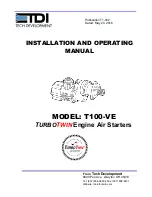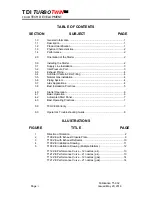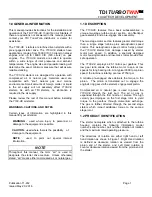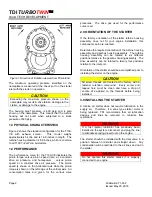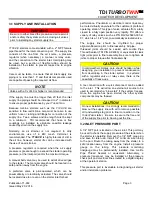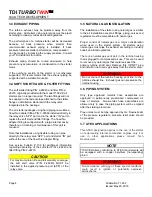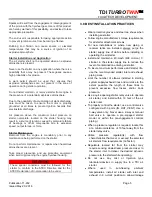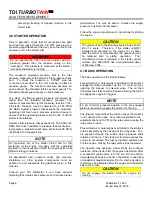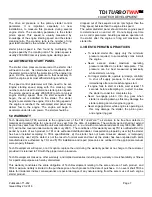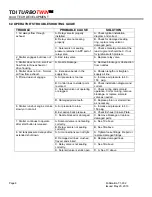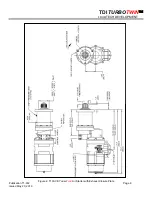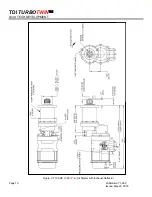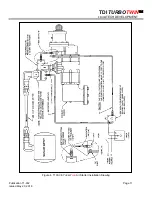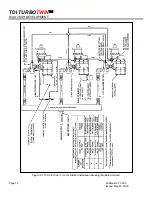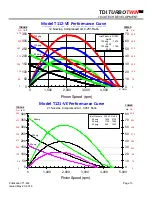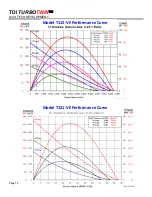
TDI TURBO
TWIN
FROM
TECH DEVELOPMENT
Publication
T1-932
Page
5
Issued May 20, 2016
Sparks will result from the engagement / disengagement
of the pinion with the flywheel gear. Users of this product
are hereby warned of this possibility, and advised to take
appropriate precaution.
The end user is responsible for taking appropriate action
to prevent ignition source from becoming effective.
Rubbing and friction can cause sparks or elevated
temperatures that may be a source of ignition of an
explosive atmosphere.
Starter Installation and Application
The air starter shall not be operated when an explosive
atmosphere is present.
Never use the starter on any application where there is a
possibility that a may be present. These gases cause a
high probability of explosion.
A work permit should be
used that ensures that
explosive atmospheres are not present in the zone of
operation during starter operation.
Do not install, maintain, or remove starter from engine in
the presence of a potentially explosive atmosphere.
Due to the possibility of accumulation of static discharge,
care must be taken to ensure the motor is properly
grounded at all times to prevent ignition hazards from
electrostatic discharge.
Air pressure above the maximum rated pressure on
starter nameplate, located on the starter housing may
result in a source of ignition caused by premature failure
of bearings or other components due to excessive
speed, output torque, or force.
Starter Maintenance
Removal from the engine is mandatory prior to any
maintenance being performed on the starter.
Do not perform maintenance or repairs when hazardous
atmospheres are present.
Take proper precaution and use protective equipment
when servicing/cleaning the engine flywheel housing.
WARNING
These special conditions must be followed for the
starter to conform to the ATEX Directive and for the
ATEX Declaration of Incorporation to be valid.
3.8 BEST INSTALLATION PRACTICES
Wear protective gloves and steel toe shoes when
installing air starter.
Follow engine manufacturer’s torque requirements
for all starter attachment screws.
For new installations or where new piping or
receiver tanks are installed,
always
purge the
starter supply line of debris before installing or
operating the air starter.
Install and maintain a 40-mesh (400 micron) Y-
strainer in the starter supply line to reduce the
level of contamination entering air starter.
To insure maximum performance and starter life,
use the recommended starter inlet and exhaust
piping sizes.
Limit the number of elbows installed in starting
system supply/exhaust lines and minimize to the
extent possible, the length of these lines to
prevent excessive flow losses and/or back
pressure.
Use a quick-opening starter relay valve to operate
air starter, and install within 10 feet of the air
starter inlet.
To properly control the starter, use a control valve
configured with 3 ports (IN, OUT, VENT). Use a
3-way valve only. Never use a 2-way or manual
ball valve to operate a pre-engaged starter
model or within the pre-engagement controls
piping.)
When a pressure regulator is required, locate this
at a minimum distance of 10 feet away from the
starter relay valve.
Utilize
pressure
regulator(s) with flow
characteristics that meet or exceed the selected
air starter’s flow requirements (Cu factor).
Regulators located far from the starter may
require sensing downstream pressure closer to
the starter inlet to deliver the desired dynamic
pressure to the starter while operating.
Do not use any mist or injection type
lubricators/devices in supply line to a TDI air
starter.
Where used in sub-freezing ambient
temperatures, install air starter with inlet and
exhaust in 6 o-clock position to allow drainage

